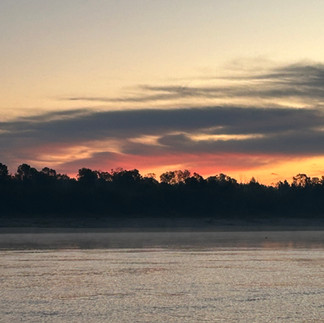Sit down, get a snack, it’s a long one.
- Ingrid Olson
- 3h
- 5 min read
Peter once quipped that sailing is 90% boredom and 10% terror. Well, Sunday morning delivered that 10% terror, at full volume. The day began in postcard fashion: clear skies, perfect temperature, and the kind of gentle morning that makes you believe the river is your friend. Then we rounded a bend and headed east.
That’s when the fog rolled in.
Visibility dropped to less than 40 feet. Hazel was now southbound, blindfolded, and barreling downriver. To make matters worse, a barge was heading north,directly on our course. We couldn’t see him. He couldn’t see us. Our only lifeline was the electronic screen and the VHF radio.
We edged Hazel as close to shore as we dared,about 20 feet off, keeping a parallel line to the bank. The barge captain and Peter stayed in constant communication, both aware we were too close for comfort and working to widen the gap. The tension? Palpable. Steering a boat with zero visibility and the looming threat of a barge collision will spike your blood pressure faster than a double espresso.
Thanks to clear, professional radio work, we passed each other, never laying eyes on the barge. Once we rounded the next bend, the fog lifted like a curtain. The day had barely begun, and Peter and I were already spent.
Strategic Moves Toward New Orleans
Sunday wasn’t just about surviving fog, it was a critical leg in our four-part strategy to reach New Orleans in daylight. As I’ve mentioned before, there’s nowhere to anchor north of the city unless you’re a commercial vessel. So our goal was to push through Baton Rouge and get south of it before nightfall.
Baton Rouge is a study in contrasts. On one hand, it’s a chaotic ballet of vessels, upstream, downstream, crosswise, and docked. On the other, it’s a global hub for oil and gas, with refineries and chemical plants lining the river like industrial sentinels.
Here’s a nugget we didn’t know: just north of Baton Rouge, all vessel-to-vessel communication switches from channel 13 to channel 67. We only learned this because a tug captain kindly hailed us on 13 to let us know. Where is this written down? Nowhere. But these captains continue to be generous with their knowledge, helping us navigate safely. And make no mistake, radio chatter here is all business. Short, precise, and purposeful. No wasted words.
Hazel the Mighty Minnow
Leg two of our strategy landed us just south of Baton Rouge. Leg three, completed Monday, went exactly as planned. But the river traffic? It’s a whole new level. The size, speed, and sheer number of vessels are staggering. The shoreline is a conveyor belt of barges, ships, and distribution centers for grain, corn, oil, gas, and methane.
One vessel we passed runs entirely on methane, no fuel oil, no smoke. Just clean propulsion. It’s a marvel. Meanwhile, Hazel has become our own version of Scuffy the Tugboat. She’s the little boat that could, weaving through giants like a bathtub toy in a sea of steel.
Peter and I agreed: we’d rather meet an ocean liner than a barge. Ocean liners glide silently, create no wake, and barely ripple the water. Barges, on the other hand, churn the Mississippi like a blender on high. You know the type.
Poised for the Crescent City
We’re now perfectly positioned to enter New Orleans tomorrow, marking the end of stage one in our global journey. It’s been a stretch of high stakes, high tension, and high gratitude. Hazel’s holding her own, and so are we.
Let’s see what the Big Easy has in store.
Little did we know how quickly a serene sky in one direction and a whisper of fog in another could shift our entire outlook. I just wanted to show you this moment, heading east, with the compass locked at 90°, and all our freshly installed gear from Memphis humming along. In the photo, you can see the fog bank we were about to enter. Visibility? About the length of Hazel herself. It’s a strange feeling, watching clarity dissolve into uncertainty, one quiet breath at a time.
Here’s a shot of the American Serenade. The next two photos feature the American Splendor, a vessel that brings to mind the classic cruise ships that once docked in Red Wing. With its authentic paddle wheel, five-story profile, and ornate woodwork, it’s a stunning example of riverboat elegance. Just a beautiful ship, through and through.
We couldn’t determine what kind of facility this is; it wasn’t marked on any of our maps. But one thing’s sure: these aren’t standard pilings for a barge tie-up. They’re long, reinforced, and clearly designed as protective barriers, likely to prevent anything from breaching the perimeter. Each column is packed with crushed rock, and they line the entire property like a defensive wall. Whatever this place is, it’s built to keep something out, or maybe in.
Finally, yes, I know, you’re probably bridge-photo'd out by now. So here’s something different: have you ever seen the bottom of a bridge? I’m guessing not many have. It’s a rare angle, and oddly mesmerizing.
As for the day itself, it started full of promise, took a sharp turn into fog-induced terror, and then, just like that, cleared into a brilliant blue sky. A full emotional arc, courtesy of the Mississippi
This is Baton Rouge. I won’t call it a beautiful city, but I will say it’s the heartbeat, or at least one of the vital pulses, of America’s petroleum industry. Every corner, every bend in the river reveals another refinery. It’s a landscape defined by stacks, silos, and the steady hum of industrial power
Yes! That is the campus of LSU on the Mississippi. Geax Tigers. (Writer's note: Dad, I love NDSU for you, but I have to mention the 2019 team of LSU that I consider the best ever. Standout players from that legendary team include Heisman Trophy winner Joe Burrow, along with star wide receivers Justin Jefferson and Ja'Marr Chase. On defense, linebackers K'Lavon Chaisson and Patrick Queen made their mark. Other notable draft picks from the roster include running back Clyde Edwards-Helaire, defensive backs Grant Delpit and Kristian Fulton, and offensive linemen Damien Lewis and Lloyd Cushenberry.)
I’ll spare you the other 50 photos, for now. Don’t worry, they’ll make their way into the blog eventually. But I couldn’t resist sharing this one, with a special shoutout to Jim Larson, manager of Central Green at the Red Wing port.
When I saw this setup, I immediately thought of Jim. Looks like he’s got some serious competition downriver, he might need to order a few more of those towering silos to keep up!
Writer's note: Lots of other photos to come - I’ve written this blog what feels like 15 times, the site I publish on is down, so bear with me :) - Ingrid





























